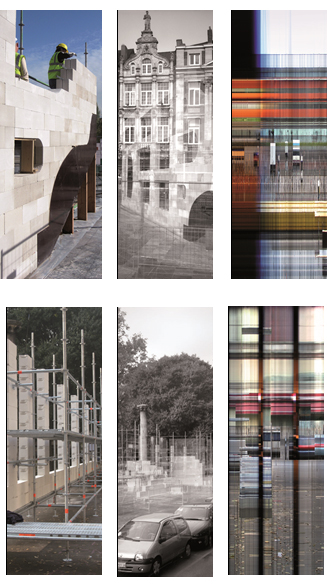Wolfgang Weileder
Wolfgang Weileder
is best known for his large-scale temporary site-specific architectural installations and sculpture, although his research also includes photography, film, sound installation and performance.
Primarily concerned with the examination and critical deconstruction of architecture, public spaces and the interactions we have with the urban environment, Weileder’s work investigates the relationship between time and space and the interface between reality and virtuality in order to question our understanding of the public sphere.

Replica
In ‘Replica’, Weileder used contemporary construction processes to engage directly with the historical and spatial parameters of two European city squares: Piazza Oberdan in Milan (Italy) and Martelarenplein in Leuven (Belgium).
The project consisted of two temporary time-based site-specific architectural scale installations and associated long-exposure photographs that referred to largely forgotten historical buildings located in or beneath public squares.
Slapende Meermin recreated the façade of a four-story house situated at the northern end of Martelarenplein in Leuven, Belgium (2008 (below left) Le Terme, developed from Diurno Venezea, a derelict 1920s subterranean public bathhouse, was realised at Piazza Oberdan, Milan (2008) (below right).
Both works raised questions about the relationship between contemporary public art and historical architecture, the uses of public spaces, and the interaction between artist, participant and audience.
To do this, Weileder and his collaborators turned and/or mirrored the existing architecture, and reconstructed it as a temporary installation in the centre of the public square e.g. the facade of the Leuven building was rotated 900 so as to appear like physical manifestations of its shadow (below left). The 8 meter long and 5 meter high subterranean structure of the Milan bathhouse, meanwhile, was mirrored to the surface and rebuilt on the piazza above, appearing like physical reflection of itself (below right).
The allusion to the shadow/mirror image within the permanent and prominent context of the squares highlighted the tension between temporality and the presumed permanence of architectural structures. Through a performative and temporary gesture, the construction of the monumental became an event, an experience in flux that encouraged the public to engage with the architectural heritage of their cities.
Both events were recorded using long exposure analogue photography and an innovative digital image recording technology developed by Weileder. The resulting ‘time-lapse’ images were exhibited as large-scale prints in two series: one black and white, the other colour. In the second series, special digital cameras took one-pixel wide recordings in regular intervals during the project, then conflated these ‘slice-recordings’ into single photographs, with time progressing from left to right.
Wolfgang Weileder, Projects 2002-2008, (solo show), ASSAB One, Milan, 2008; Le Terme e La Sirena, (solo show), Ciocca Arte Contemporanea, Milan, 2009; To The Demon King’s Castle, of course, (solo show with M+M), Workplace Gallery, Gateshead, UK, 2009.
Slapende Meermin, was commissioned by STUK Kunstencentrum and realised by Weileder in collaboration with R.Bau Ltd (South Tyneside), Newcastle College UK, and Wonen en Werken, Leuven. Slapende Meermin was presented as part of the STUKSTART festival in Martelarenplein, Leuven, Belgium, in 2008.
Le terme, was co-funded by Galleria Ciocca Arte Contemporanea and Arts Council England and exhibited in Piazza Oberdan, Milan in 2008. Collaborators here included Politecnico di Milano, ASSAB-One Milan and Spazio Oberdan and the construction of the work was sponsored by UK and Italian construction companies (r.Bau Ltd, Layher and Gasbeton).
